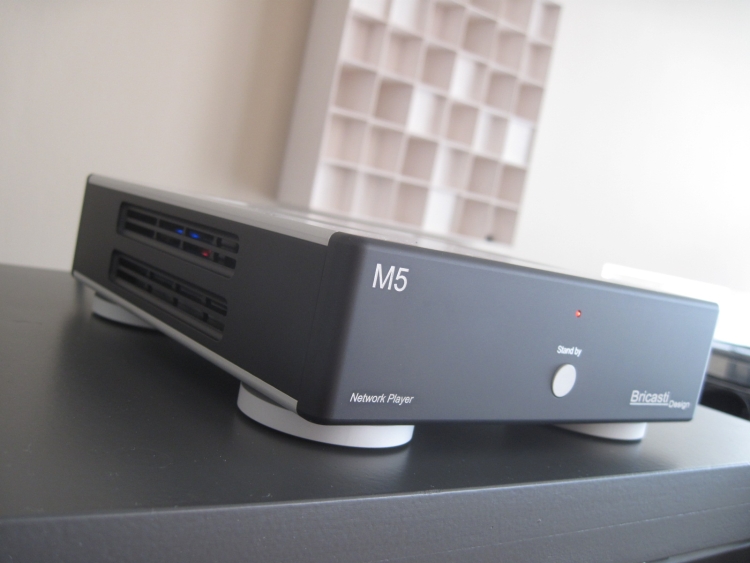
The Perfect Roon Ready Streaming Endpoint
Review sample kindly supplied by Ohm Audio
Retail price in the Netherlands 2495 euro
Let’s get the obvious out of the way first. Squeeze Lite and Roon Ready are both freely available and run on almost all hardware. One can build a perfectly functional endpoint for very little money indeed. But does this guarantee good sound? Actually no. Taking the do-it-yourself route can produce satisfying results, but in my experience, you don’t get all the way there. By using clever motherboard design, bespoke components, custom made power supplies and smartly tweaked software, manufacturers are able to produce devices that sound significantly better than the best do it yourself efforts that I have heard.
As always in audio, obtaining reference-class sound does not come entirely cheap, but at under 2500 euro the M5 is certainly also not hugely expensive. Actually taking its incredibly high-end build quality into account I would say that it even borders on being affordable. Yes, I know a Sonos Connect is really affordable, but its sound does not get past that of a 300 euro CD player. With the right combination of hardware and software, however, one can obtain streaming hardware to beat even the best CD players.
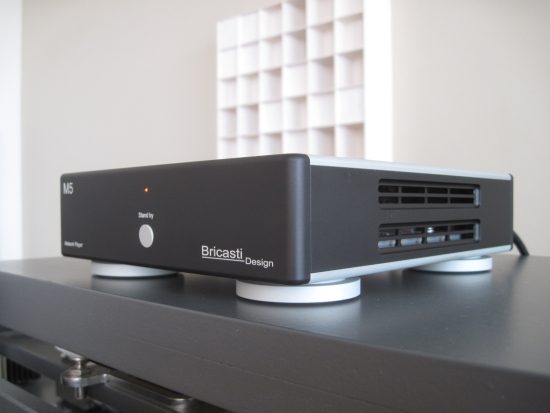
Design Brief
According to the manufacturer, the objective of the M5 was to make a network bridge and solve the problem areas of other products like this. To this end they employed a linear power supply with custom-wound transformer. The chassis is made with low vibration and good thermal dissipation in mind amd the linear regulator heat sink has been precisely milled to connect and dissipate heat and vibration into the chassis. Bricasti offer USB on the M1 DAC and M5 endpoint but do indicate that in principle USB can be another source of noise due the power on the line and the computer where it’s sourced.
Not only the power supply is custom made, but the digital parts are also too, so no off the shelf computer motherboard here. According to Bricasti, these are usually loaded with switching power regulation, so they made their own ARM processor Linux based system. In addition, their own player/renderer is used, and without any processing overhead for unnecessary processes such as occur when using a PC type motherboard for music playback.
The USB output also received special care, being fed by a stable linear 5V supply, rather than the more usual noisy switching regulation.
All playback and rendering is done in the M5, not the host server computer, and all the server does is send or instruct that the files from the storage be sent to the M5 for playback, so the noisy computer and drives can then be located away from the listening room. This eliminates physical noise and further minimizes electrical inducted noise from the server.
The M5 connects to LAN via Ethernet and Wi-Fi (via a USB dongle), with SPDIF and AES outputs supporting sample rates up to 192k PCM and DSD 64 and DSD 128 over USB.
The unit is available with RCA or BNC connector and I should add that this does indeed make an audible difference.
Currently, the M5 is still pending RoonReady certification but already works perfectly using RAAT.
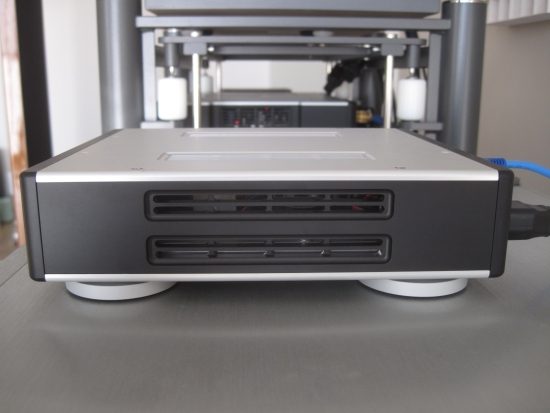
RoonReady and Audirvana
The M5 offers support for DNLA and other popular network protocols. Currently, the M5 is pending RoonReady certification, but I can already confirm that it works perfectly and also sounds perfect, using RAAT.
Update 25-08-2017: M5 is now Roon certified, and this is visible from Roon Build 1.3 259)
In addition to Roon, I understand that the M5 also works with Audirvana, but this I have not tried. I mean, when you’ve got Roon, what else do you need?
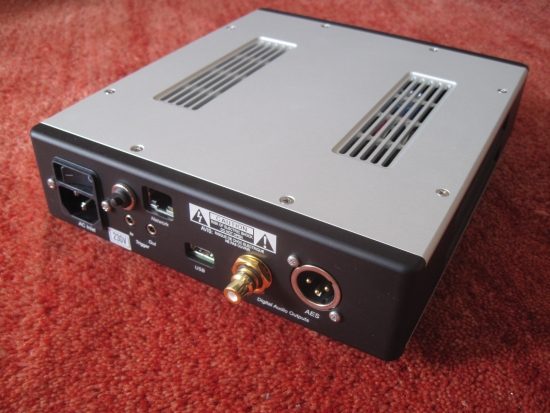
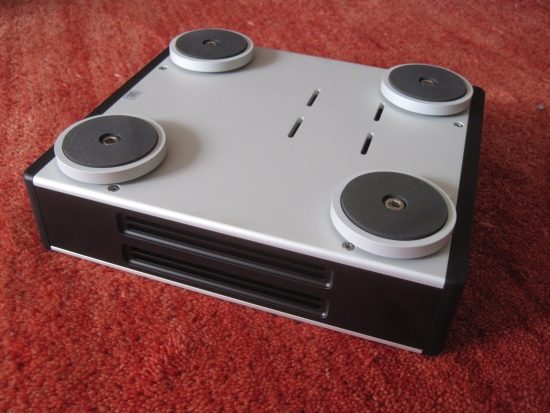
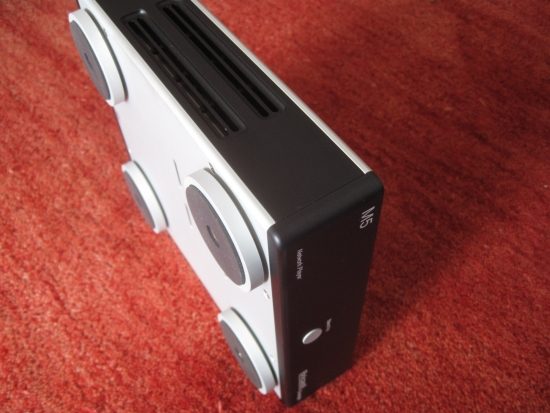
Above: no matter the angle: the M5 is superbly finished.
Judging a book by its cover
Purists might not find this important, but the M5 has very attractive looks and is very well built. Level of execution is identical to that of the M1 DAC. Actually, when the M5 is stacked on top of the M1, its width precisely fits in the middle section of the M1 front panel depression. Like the M1, the M5 endpoint is built on a heavy and thick milled-from-solid aluminum base, has a similarly massive machined front panel, with further precisely machined aluminum panels on side and top. All these parts are milled and assembled in-house. It really has the looks of a high-end audio device, and although it also must sound good, for me this is definitely a plus. I should add that I am quite certain that a solid casing like this will actually be audible in the final sound, as a less stressed sound I imagine. But this is purely speculation on my part.
The DAC used throughout this review is the Bricasti M1 and comparisons are made with the Aurender N10 and Antipodes DS Base.
Cables
Power cables as always do make a difference, but as with music servers, their influence likely is not strictly on the component that they are connected to but rather on the other components that are connected to the same power extension block. For example, by using a smooth sounding FP-TCS31 or Black Rhodium Stream the overall sound of the system does become smoother and more relaxed, but in my opinion, the M5 really does not need such tweaking. I feel that it sounds best with a neutral power cable such as the standard one that comes in the box, or a Belden.
Digital cables also are of influence on the sound, and more than one might expect. I have made the decision however to stick with industry-standard cables for all review comparisons. Just note that one can tweak the sound of any digital component a little to the warmer side, or the cooler side, just as required. A Wireworld Gold Starlight 3+ or just about any Transparent Audio cable will sound smoother and more mellow, and perhaps friendlier in some systems while cables from such brands as Nordost and Ansuz sound tighter and more articulate. Belden RG59 coax sounds somewhere in between, and almost always perfectly fine to me.
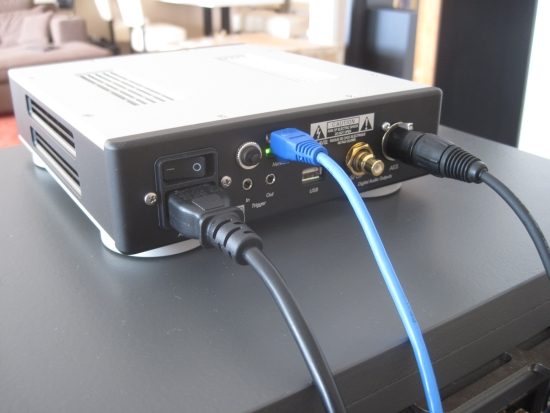
AES/EBU
Upon first listen with the Aurender using USB (AudioQuest Diamond) and the M5 using AES/EBU (Belden 1800F), the M5 immediately impresses with a very organic and liquid sound, that is simultaneously supremely solid in the bass as well as fluid and airy in the treble. Soundstaging is wide yet precise and overall this is a very likable and forgiving sound, but compared to the more agile (or more slender?) Aurender N10 and Antipodes DS Base, the M5 is perhaps a little bit too “phat”. This would quickly turn out to be caused by the combination of cable and output though.
Coax
Using its coax output with a Belden RG59 coax cable the M5 sounds quite different than with AES, but this may well be mostly influenced by the differences between the flexible Belden 1800F stranded wire and more sturdy Belden solid core RG59 cables used. Regardless, the difference between the two outputs is considerable: with coax, the sound is faster overall, more nimble in the bass and more forward and open in the midrange. It’s still not a forward sound at all, not in a negative way I mean. The midrange has just the right amount of sprite and sparkle, but remains civilized. With coax, the overall sound is still nicely smooth and sonorous and the stage is still widely projected into the room, but the overall sound is just less overtly creamy and relaxed than when using AES.
Taking care while swapping USB cables
Although the M5 has moved closer to the Aurender by using its coax output rather than AES, the remaining output to listen to is its USB output. Sadly no DAC I know has multiple USB inputs and so the cable has to be switched from source to source. One might think this is no issue at all, but it is important to understand that USB inputs can be damaged when switching cables with the sources still powered on. It is for this reason that I started the comparisons with two non-identical inputs. After switching off the sources and swapping the USB cable, the comparison continues with reverse wiring, this time with the Bricasti M5 using USB and the Aurender using coax.
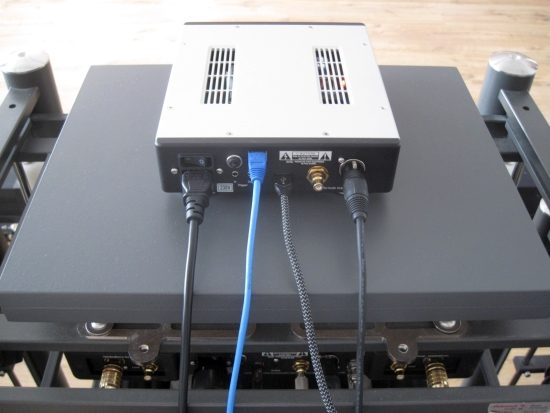
Above: although the M5 does not sit directly on the Artesania feet, the MDF board on which it sits, does.
USB
Connected via USB the Bricasti definitely sounds best to my ears. This way it retains all of the organic and full-bodied sound, large soundstage and superbly sonorous bass that the coax output provided, but gains more speed and attack as well as more overall liveliness. So far the latter was one of the main dividers between the DS and M5, but with USB the two come closer together.
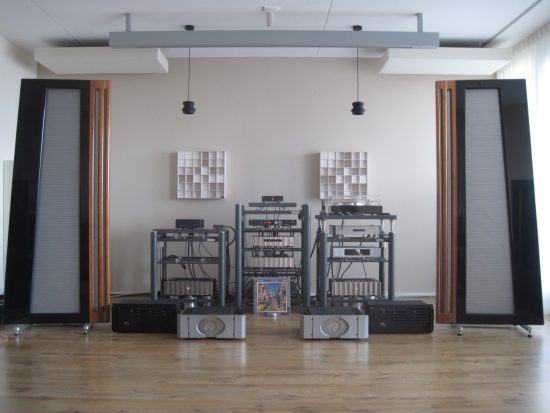
Above: the entire main setup, with VTL and Pass amps visiting briefly. A review describing these amps in more detail will appear soon.
Comparing again to the Aurender the M5 actually turns out to have made considerable gains across the board using USB, as it now plays at least at the same overall level. Granted the Aurender now plays via coax, but I have experimented with this a lot, and the Aurender sounds pretty similar using coax and USB and what differences there are, do not change it this much. The only conclusion is that the Bricasti did indeed improve significantly using USB.
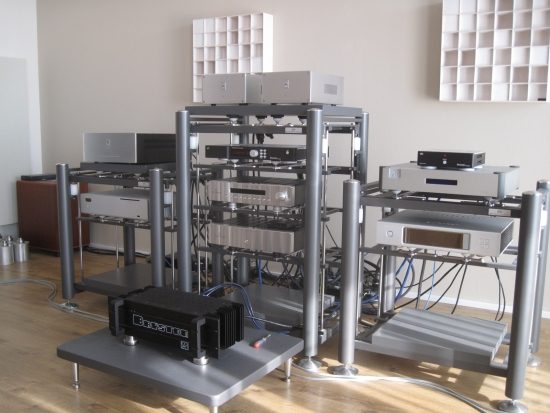
Above: lately I have been enjoying the muscular Bryston sound again. In terms of bass and overall tonality the 3B ST is not very different from the Pass amps above. Although my usual Rowland sixes are more powerful on paper, the 3B ST definitely makes the Divas sound more powerful in the bass and overall better controlled, if not nearly as refined. The quest naturally continues…
Comparisons
The Antipodes DS as an endpoint fed from the same source and using USB does not quite image as widely and does not have the Bricasti’s solid bass or organic midrange. The DS does sound more spritely and forward but is a little bit uneven at it and not quite as subtly refined.
The M5 positively shines using USB. In a way, it has picked up some of the enthusiasm and liveliness of the Antipodes DS while retaining all of its smooth, organic and relaxed character and for this reason, I feel that it provides an overall more high-end rendition. Naturally, this is also a matter of taste and system matching, but when taking the Aurender as a reference, the M5 has a different character but sounds closer to it in terms of overall refinement than does the DS. Taste matters aside (although I can’t stop talking about its superb bass and gloriously lush midrange), this gives the M5 the edge.
This is only fair of course, as the two components are in the same price range but the Antipodes functions as a fully-fledged SSD/HDD Music Server while the Bricasti M5 focuses solely on being an endpoint. At the same cost, it should also be better. What’s more, even when used with a standard computer running Roon server and RAAT protocol it sounds so very good that one can question the necessity of having a dedicated music server such as the Aurender.
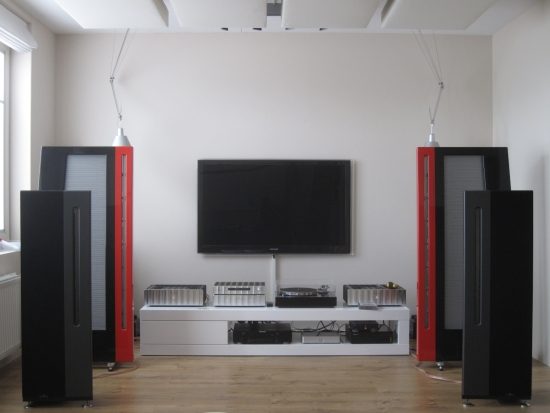
Above and below: the M5 was also used in the newly created second system, where it also performed exceedingly well with the Exogal Comet DAC. Both speakers were tried and in particular, the smaller Apogee Centaur hybrid ribbon speakers were telling, as their tweeter ribbons are especially unforgiving if anything is wrong downstream. With the M5 the Centaurs sounding as airy and refined as they can be.
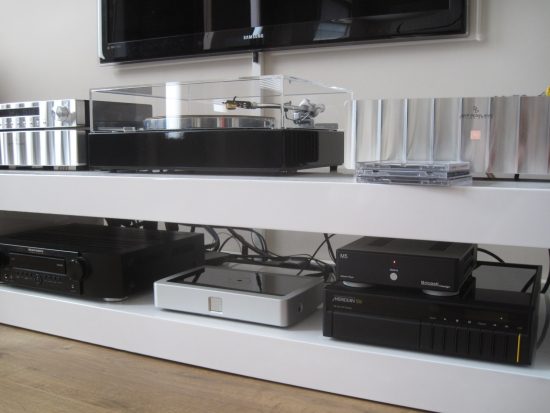
Summing it up
If it wasn’t for the Antipodes DX, then the M5 would be the absolute best RAAT endpoint I have heard so far across the board, cost being no object. The Meridian 818v3 was also incredibly good, but was judged using its built-in DAC, so it cannot really be compared. Anyway, these alternatives cost several times the M5’s very reasonable asking price.
While I obtained the best sound for my taste and setup using USB, I would encourage to experiment with different cables and cable types, and try each of the M5’s outputs. You’ll find that they all sound slightly different, and this way the sound can be tweaked precisely as needed.
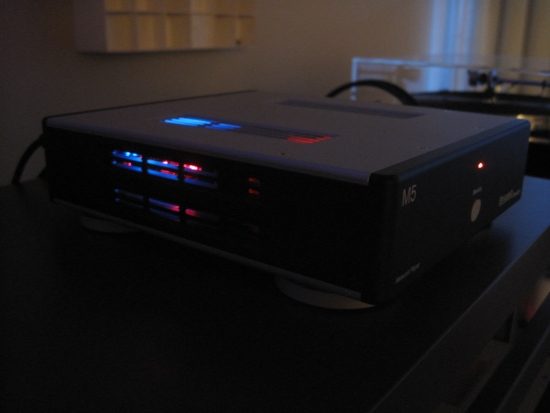
Above: just like the M1, the M5 has several colors of lighting going on inside which makes for interesting effects at night.
Nags
Only a minor one: The power indicator led flashes at when the unit is in standby, and I find this a little distracting. The reason for this is the support for the trigger-in function as part of system building. When connected with a Bricasti M12 or M1 (or another preamp with a trigger out ) and other Bricasti products such as for example a power amp then they could all be triggered on from the M12 or the M1. To make this possible there needs to be a standby stage. The only way to indicate 3 states with one LED is to use blinking. The LED blinks slowly when in full standby, then when the trigger voltage comes from the preamp it blinks faster and becomes solid once the network is found. Bricasti found that using multiple, or differently colored LEDs would detract from the otherwise very similar appearance of all Bricasti products. Either way, there is no harm in always leaving the unit switched on, which is what I do.
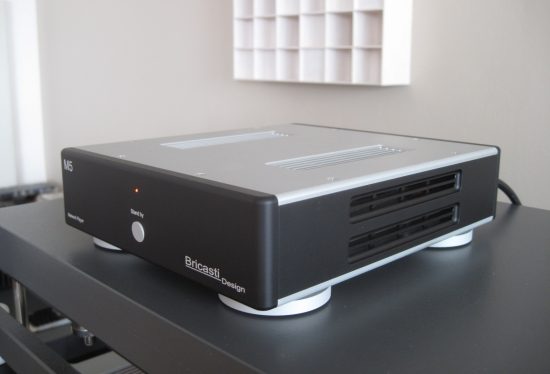
Conclusion
The M5 is built extremely well and absolutely has the looks to fit a true high-end audio device, but it also has sound to match its looks. It has superbly deep, powerful and tuneful bass, rich and smooth mids and fluid, airy treble and overall it is easily the most organic sounding Roon endpoint that I have heard. If there is one thing that the M5 does not do, it is sounding digital!
Using RAAT and any server running Roon Server, M5 not only offers more sonorous bass and a more luscious midrange, but its overall sound quality is also all the way at the level of the four times as expensive Aurender N10 music server, and that makes it almost a bargain!

Videos on the Hifi-Advice YouTube Channel
How Sooloos became Roon
HFA Front Page
Try out Roon for yourself
External Links
Manufacturer: Bricasti
Distributor for the Netherlands: Ohm Audio
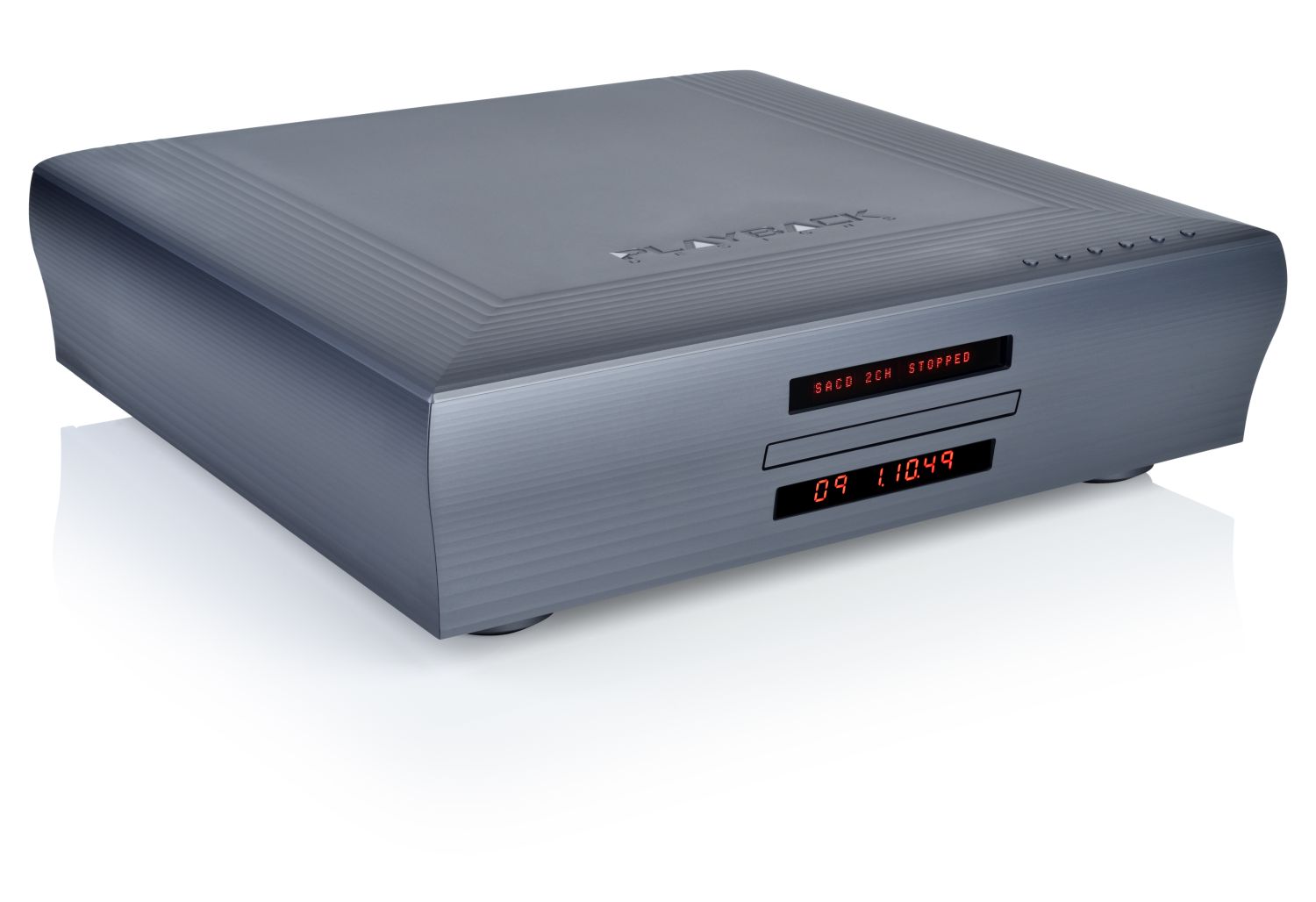







Thank you for the review. This seems just what I need as streamer to replace my Aurender and work with Roon (on a server). Did you know that Bricasti is also coming with a network card that can be added to the Bricasti M1 and will be Roon Ready?
Hi Chantelle, indeed I am aware of the Roon Ready add-on card for the M1 (same as the one used in the M5 minus extra power sypply), and this is mentioned in the M1 review. AFAIK the card costs around 1000 USD, so is a very interesting option, if you have an M1 DAC.
“…manufacturers are able to produce devices that sound significantly better than the best do it yourself efforts that I have heard…”
Why do you think that this mythical, godlike himself “MANUFACTURER” is smarter, wiser than I am?
He’s just a man, like you and me – an experienced I.T. guy.
And I assure you, that my “do-it-yourself “, rather cheap IT music system, based on “Audirvana” and “Win10” PC renderer, sounds great – in compare to once borrowed VERY expensive DACs and renderers…
Simply – byte in the LAN and in the memory is just a byte – nothing more or less.
Can you imagine what would happen with internet banking if there are any “good” and “bad” bytes?
For safe banking would be needed a special, VERY expensive equipment, made by “MANUFACTURER”…
Again the old bits are bits argument – they are, but they also are not. I understand what you are saying though, and I also have no all encompassing explanation, but an important thing to realise is that there is difference between sending data a connection and running it after completion of the copy process and and real time decoding as happens with streaming audio. A careful ear can easily pick up the differences between digital cables (even USB) and one network renderer or another.
There are various articles on this site (and elsewhere) that try to explain what is going on, but in short (in asfar as we have a current understanding of this) in digital audio, timing is everything.
There is no black art, indeed it is about diligent and sane engineering. It’s just that some specialists pay attention to factors which other manufacturers deem uninportant, which turn out to make a real difference. These are perhaps not world-changing differences such as those between swapping one pair of speakers for another and depending on the rest of the audio setup they may even seem insignificant. Indeed a home made solution can sound very good (I’ve used various), but given a revealing enough system, the differences between a Windows PC and a standard VortexBox install are definitely there and they are worth the extra expenditure for me. The same difference is there between a VB machine and an Aurender, Antipodes or Bricasti, which again all sound different from one another. If you pay enough attention to the power supply and implement the protocols properly and without introducing jitter or other detractive artefacts then you may well be able to build a network renderer that approaches or even sounds as good as the M5, but I just have not stumbled across one such home made device that does. Why not? Propably because people tend to take shortcuts and save cost. The best Raspberry Pi solutions that I heard were impressive, especially at the cost, but none sounded as refined or as full-bodied as the M5. Anyway for me, with the Rowlands and Apogees, these differences can make the distinction between listening and being moved. As always YMMV.
Greetings Christiaan,
I have read both your reviews on the Bricasti M5 and the Antipodes DS, i really enjoyed both, leaving my gut in suspense…
Please let me explain my situation so far:
Well i have spent all the 2017 reading and trying to decide what path i am going to take to maximize the SQ of my system with a server/renderer/transporter/or:
Among some:
SOtM sMS-200ultra & sPS-500 power supply
The Host from Clones
Zenith MKII from Innuos
Sonore Ultrarendu with Uptone LPS-1
But now after reading the Bricasti M5 review i’m/was almost done for it…BUT after reading the DEDICATED review on the Antipodes DS, i am having my doubts:
My music preference is mostly Rock and i want the most involving, clean-noise free, BIG, smooth and relaxed music experience
What would be your very best suggestion Bricasti M5 or Antipodes DS?
This is my system:
MacMini (late 2012)
Hegel P20 (preamp)
Hegel H20 (amp)
OPPO 205 (DAC)
PMC Twenty5.26 (front speakers)
Uptone ISO REGEN & LPS-1
Curious (USB cable)
LessLoss (Power and XLR)
Topaz (Transformer Isolator)
Oyaide (DIY power bar)
I hope you can guide mea little bit to make my final decision
All the best and kind regards!!
Miguel
Hi Miguel,
Well, the Antipodes and the M5 are both great products, the decision will really come down to taste. You mention playing rock and that would nudge my recommendation toward the Antipodes because it has more of a foot-tapping quality. However you also mention wanting a smooth, big and relaxed sound and that then points toward the Bricasti which is really silky smooth whereas the Antipodes can be a little rough, which again I think makes it great for rock. Now whether the M5 is rounded off and making things nice than they are and the Antipodes adds edge or is simply more honest is up for interpretation. You also mention Involvement and this is a personal matter. Are you more involved when music sounds fluid and relaxed or are you more involved when it sounds fast and dynamic? Main decision point for you will be: do you favor dynamic attack and fast pacing over lushness and smoothness or vice versa. Hope this helps!
BTW the USBRegen will likely work better with the Antipodes than the Bricasti. The latter should be connected directly. I found that the USB Regen can make the sound smoother and more fluid, taking away edge, but potentially also taking away some snap and dynamic attack. You might want to experiment with this to find the best balance in your system.
Thank you Christiaan!!
Hello,
What is the wood shelf added on the Artesania Exoteryc rack ?
What is the benefit instead put directly the source on isolation base ? Is is working better on some components ?
Thanks and regards,
Pat
Hi Pat, That is a shelf comprised of two layers 16mm MDF board glued together that I made to allow easy placement of small components. Although it is only “sandwiched” between the Artesania’s feet and the component’s feet (the M5 in this case), the shelf, and possibly the component’s feet, do add a mild colouration and thickness to the sound. Not unpleasant at all, but a deviation from neutrality nonetheless. In this sense the shelf is not an improvement and not something that I would recommend. But because I am fully aware of the nature of the added effect and because I often use it for small components, I can still properly review a component while using it. When in doubt I just remove it and adjust the Artesania feet such that they can support the component under review.
Hello Christiaan,
I read many of you reviews and I am convinced that you sound preferences are very similar to mine. As your are, I am a big fan of Wadia, I still using the 27ix and although I believe that some areas can be improved, I like it a lot. I have been using a qsonix server with wadia output card, upgraded power supply and mit super expansive coax cable and it approach the sound of the 270 transport (not better). Due to the fact that qsonix is have been out of business for many years so no support is available and I loss the iPad application, I need to buy a new server. My question is, do you have plan in the near future to review the Auralic Aries G2? For me this is an excellent solution because it have several digital outputs options so I can still use my 27ix for a while until I find a better D/A. It will be good to know your opinion of this streamer / server and it will be interesting to review the Vega G2 also with and wthiout the Aries special link. Thanks, Carlos
Hi Carlos, alas, I tried to review the Aries G2 but the manufacturer directs me to the distributor and vice versa resulting in a dead end. I guess in this case it’s a disadvantage of being a Dutch writer based in the Netherlands, writing English articles for global reading. All I can say at this point with the requirement for multiple connectivity options is that you could look at an Aurender or, knowing your preference for the Wadia-esque, better still, an Antipodes server such as the DX. I know these don’t look as sexy as an Aurender or the Aries G2, but this is likely a better match for your taste. BTW I think the 27ix is still an excellent DAC, as is the 521. The trouble is that once you are married to the Wadia sound, it becomes hard to find an overall better replacement of another brand while retaining all the Wadia strong points. But I guess you know that already from reading my reviews:-)